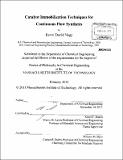Catalyst immobilization techniques for continuous flow synthesis
Author(s)
Nagy, Kevin David
DownloadFull printable version (36.87Mb)
Other Contributors
Massachusetts Institute of Technology. Dept. of Chemical Engineering.
Advisor
Klavs F. Jensen.
Terms of use
Metadata
Show full item recordAbstract
Catalytic processes are ubiquitous in both research and industrial settings. As continuous flow processes continue to gain traction in research labs and fine and pharmaceutical chemical processes, new opportunities exist for implementing previously difficult catalytic transformations. The major goal of this thesis is to expand and evaluate techniques for immobilized catalyst systems relevant to continuous flow. Fundamental studies in characterizing mixing, dispersion, and residence time distributions in small scale continuous flow systems are also presented. Given the numerous benefits associated with studying chemical processes at small length scales, microfluidic devices are the tool of choice for most studies in this thesis. Thermomorphic solvents offer the potential for homogeneous catalytic processes with biphasic catalyst recovery and recycle. A major limitation of these processes is the number of synthetically useful thermomorphic solvent combinations demonstrated in literature. A screening program using the modified UNIFAC (Dortmund) activity coefficient model to evaluate phase splitting behavior has been developed to predict thermomorphic behavior. Calculation of 861 binary solvent combinations results in 43 potential thermomorphic and 44 biphasic solvent combinations. Extension of the program to ternary solvents resulted in a new class of ternary solvents that display thermomorphic behavior with tunable critical solution temperatures. Evaluation of thermomorphic processes as a general method is presented. Traditional catalyst immobilization techniques rely on covalent grafting and are well suited to continuous flow processing due to the strong interactions of the catalyst to the support. Fluorous physisorption, which relies on interactions between a fluorous support and a fluorous-tagged catalyst, is characterized and presented as an immobilization technique for flow chemistry. The use of a fluorous-tagged Co(III)-salen catalyst to effect the ring opening of epoxyhexane with water is presented. Application of the platform to the ring closing metathesis of N,Ndiallyltosylamide using a fluorous-tagged Hoveyda-Grubbs metathesis catalyst results in significantly accelerated loss of activity over time compared to the salen catalyst. Use of continuous flow selective adsorption reactors to enhance catalytic processes is presented. Continuous feeds of a homogeneous catalyst into a sorbent where the catalyst displays an affinity for the sorbent results in accumulation of the catalyst in the packed bed. The net effect is an enhancement in turnover frequency and turnover number relative to homogeneous flow. Application of this platform to a Lewis acid catalyzed Diels-Alder reaction results in an order of magnitude improvement in turnover frequency compared to batch and homogeneous flow.
Description
Thesis (Ph. D.)--Massachusetts Institute of Technology, Dept. of Chemical Engineering, February 2012. Cataloged from PDF version of thesis. Includes bibliographical references (p. 181-199).
Date issued
2012Department
Massachusetts Institute of Technology. Department of Chemical EngineeringPublisher
Massachusetts Institute of Technology
Keywords
Chemical Engineering.